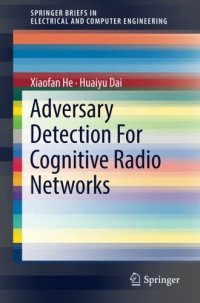
Ebook: Adversary Detection For Cognitive Radio Networks
Author: Xiaofan He Huaiyu Dai
- Tags: Internet Groupware & Telecommunications, Networking & Cloud Computing, Computers & Technology, Networks, Networks Protocols & APIs, Networking & Cloud Computing, Computers & Technology, Security & Encryption, Cryptography, Encryption, Hacking, Network Security, Privacy & Online Safety, Security Certifications, Viruses, Computers & Technology, Telecommunications & Sensors, Antennas, Microwaves, Mobile & Wireless, Networks, Radar, Radio, Remote Sensing & GIS, Satellite, Signal Processing, Telephone Systems, Television &
- Series: Springer Briefs in Electrical and Computer Engineering
- Year: 2018
- Publisher: Springer
- Edition: 1st
- Language: English
- pdf
This SpringerBrief provides a comprehensive study of the unique security threats to cognitive radio (CR) networks and a systematic investigation of the state-of-the-art in the corresponding adversary detection problems. In addition, detailed discussions of the underlying fundamental analytical tools and engineering methodologies of these adversary detection techniques are provided, considering that many of them are quite general and have been widely employed in many other related fields.
The exposition of this book starts from a brief introduction of the CR technology and spectrum sensing in Chapter 1. This is followed by an overview of the relevant security vulnerabilities and a detailed discussion of two security threats unique to CR networks, namely, the primary user emulation (PUE) attack and the Byzantine attack.
To better prepare the reader for the discussions in later chapters, preliminaries of analytic tools related to adversary detection are introduced in Chapter 2. In Chapter 3, a suite of cutting-edge adversary detection techniques tailor-designed against the PUE and the Byzantine attacks are reviewed to provide a clear overview of existing research in this field.
More detailed case studies are presented in Chapters 4 – 6. Specifically, a physical-layer based PUE attack detection scheme is presented in Chapter 4, while Chapters 5 and 6 are devoted to the illustration of two novel detection techniques against the Byzantine attack. Concluding remarks and outlooks for future research are provided in Chapter 7.
The primary audience for this SpringerBrief include network engineers interested in addressing adversary detection issues in cognitive radio networks, researchers interested in the state-of-the-art on unique security threats to cognitive radio networks and the corresponding detection mechanisms. Also, graduate and undergraduate students interested in obtaining comprehensive information on adversary detection in cognitive radio networks and applying the underlying techniques to address relevant research problems can use this SpringerBrief as a study guide.